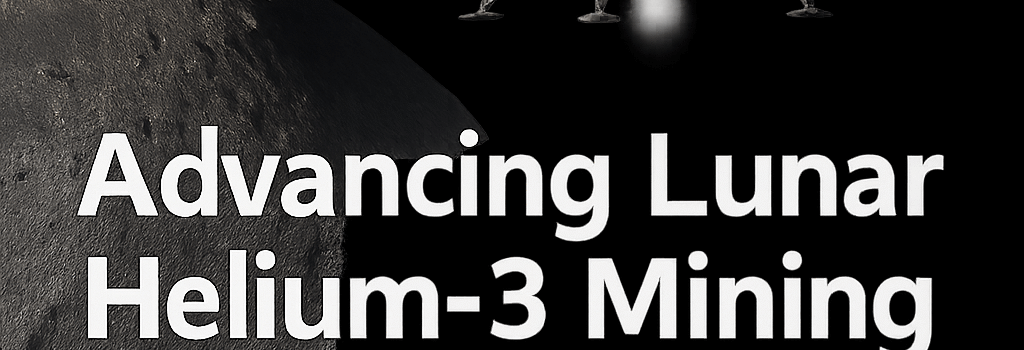Advancing Lunar Helium-3 Mining with Interlune and Vermeer

Interlune’s ambitious plan to sift lunar regolith for helium-3—a rare isotope with high value in cryogenics and potential future fusion—has taken concrete steps forward with its partnership with industrial giant Vermeer. This article delves deeper into the technical underpinnings, policy catalysts, and market dynamics that are bringing this long-shot lunar venture closer to reality.
1. The Promise of Helium-3 and Market Drivers
Helium-3 (³He) is a stable isotope composed of two protons and one neutron. Produced in the Sun and delivered to airless bodies by the solar wind, ³He is extremely scarce on Earth due to our magnetosphere’s shielding effect. Lunar regolith, however, traps ³He in nanopores, yielding an estimated 1–50 parts per billion by mass.
- Cryogenic Applications: ³He refrigerators can achieve base temperatures down to 0.2 K—critical for superconducting qubits and dilution refrigerators in quantum computing.
- Future Fusion Fuel: While pure ³He fusion reactions are aneutronic and generate minimal radioactive byproducts, they require plasma temperatures exceeding 1 billion °C and remain a long-term goal.
- Supply Constraints: Terrestrial ³He is recovered as a byproduct of tritium decay in nuclear weapons stockpiles or extracted from natural gas at <$10 L per thousand dollars.
“Our near-term focus is cryogenics, where demand from quantum infrastructure firms is immediate and scalable,” said Rob Meyerson, CEO of Interlune.
2. Prototype Excavator: Design and Test Results
In April 2025, Interlune and Vermeer unveiled a mid-scale excavator capable of processing 100 metric tons of lunar simulant per hour under terrestrial conditions. Key specifications include:
- Mass & Power: 1,200 kg unit drawing 50 kW from a modular powerpack, replicating photovoltaic output on the Moon (~300 W/m² at equatorial midday).
- Digging Mechanism: Dual counter-rotating drums with tungsten-carbide picks engineered to fracture basaltic regolith analog at 50 MPa compressive strength.
- Conveyor & Separation: A two-stage pneumatic classifier separating <100 μm fines—optimized for ³He adsorption—followed by electrostatic removal of residual dust.
Test data revealed an energy cost of ~0.5 MJ per kg of feedstock, aligning with design targets. Vermeer’s board member and former JPL engineer Jason Andringa will contribute flight-heritage systems engineering expertise to accelerate the next prototype.
3. Technical Roadmap and Architecture
Interlune’s phased development plan hinges on evolving launch and lander capabilities:
- 2027 Prospecting Mission: Sub-100 kg payload on NASA’s Commercial Lunar Payload Services (CLPS) lander. Objectives include in-situ ³He concentration measurements via laser-induced breakdown spectroscopy (LIBS).
- 2029 Pilot Plant: A 2-ton mobile pilot to validate excavation, thermal control, fine-particle handling in lunar vacuum (<10⁻⁸ torr), and autonomous navigation.
- 2032 Solar-Powered Operations: Deploy five 8 ton harvesters and a 20 kW solar array on Starship or dual New Glenn Mk 2 landers to produce ~100 kg ³He per year.
Key systems integration challenges:
- Thermal management: Radiator sizing to reject 20 kW of waste heat in extreme lunar day/night cycles.
- Dust mitigation: Hybrid electrostatic and vibrational cleaning on optical sensors, joints, and radiators to prevent abrasion.
- Teleoperations vs. autonomy: High-latency (>2.5 s one-way) communications demand onboard AI for hazard detection and path planning.
4. Regulatory and Policy Landscape
Recent shifts in U.S. space policy bolster private lunar exploitation:
- Artemis Accords: Clarified resource extraction norms under international law, providing legal certainty for ³He mining patents.
- DOE Offtake Agreement: A binding contract to purchase 3 L of lunar-sourced ³He by April 2029, signaling federal support.
- Leadership Changes at NASA: Potential nomination of pro-lunar mining advocates promises increased CLPS funding and streamlined licensing.
“A robust regulatory framework is essential to attract the hundreds of millions in capital we need,” noted Dr. Lydia Vernon, a space economist at the University of Colorado.
5. Economic Viability and Market Analysis
With Maybell Quantum committing to purchase thousands of liters of helium-3 between 2029–2035, Interlune can underwrite pilot operations. Preliminary cost analysis suggests:
- Levelized Cost of ³He: Estimated at $7,500 per liter delivered to LEO, excluding Earth re-entry and purification expenses.
- Capital Expenditure: $200 M for the pilot plant, rising to $1 B for full five-unit deployment and return capability.
- Return on Investment: Based on current quantum market growth projections (CAGR ~30%), break-even by 2038–2040.
However, price volatility in terrestrial helium markets and potential competition from in-orbit cryocooler recycling could impact long-term returns.
6. Comparative and Global Landscape
China’s Chang’e rover program has conducted ground-penetrating radar surveys for ³He enrichment, while ESA’s Lunar Resource Mapping (LRM) mission will launch in 2026 to globally map volatile deposits. Interlune’s focus on purely commercial extraction sets it apart from government-led prospecting efforts, positioning the company as a potential lynchpin in an emerging lunar economy.
As Interlune prepares for its next funding round—targeting $50 million—its tangible progress from paper concept to field-demonstrated excavator elevates lunar mining from science fiction toward engineering reality.